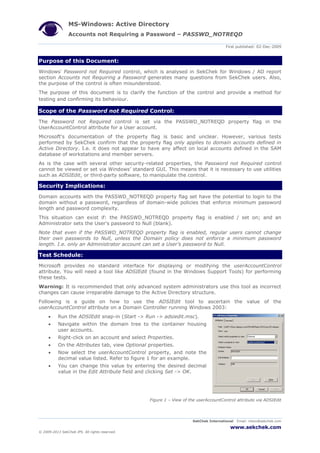More Related Content
Similar to windows-active-directory-accounts-not-requiring-a-password
Similar to windows-active-directory-accounts-not-requiring-a-password (20)
windows-active-directory-accounts-not-requiring-a-password
- 1. MS-Windows: Active Directory
Accounts not Requiring a Password – PASSWD_NOTREQD
First published: 02-Dec-2009
SekChek International Email: inbox@sekchek.com
www.sekchek.com
© 2009-2013 SekChek IPS. All rights reserved.
Purpose of this Document:
Windows' Password not Required control, which is analysed in SekChek for Windows / AD report
section Accounts not Requiring a Password generates many questions from SekChek users. Also,
the purpose of the control is often misunderstood.
The purpose of this document is to clarify the function of the control and provide a method for
testing and confirming its behaviour.
Scope of the Password not Required Control:
The Password not Required control is set via the PASSWD_NOTREQD property flag in the
UserAccountControl attribute for a User account.
Microsoft's documentation of the property flag is basic and unclear. However, various tests
performed by SekChek confirm that the property flag only applies to domain accounts defined in
Active Directory. I.e. it does not appear to have any affect on local accounts defined in the SAM
database of workstations and member servers.
As is the case with several other security-related properties, the Password not Required control
cannot be viewed or set via Windows’ standard GUI. This means that it is necessary to use utilities
such as ADSIEdit, or third-party software, to manipulate the control.
Security Implications:
Domain accounts with the PASSWD_NOTREQD property flag set have the potential to login to the
domain without a password, regardless of domain-wide policies that enforce minimum password
length and password complexity.
This situation can exist if: the PASSWD_NOTREQD property flag is enabled / set on; and an
Administrator sets the User's password to Null (blank).
Note that even if the PASSWD_NOTREQD property flag is enabled, regular users cannot change
their own passwords to Null, unless the Domain policy does not enforce a minimum password
length. I.e. only an Administrator account can set a User’s password to Null.
Test Schedule:
Microsoft provides no standard interface for displaying or modifying the userAccountControl
attribute. You will need a tool like ADSIEdit (found in the Windows Support Tools) for performing
these tests.
Warning: It is recommended that only advanced system administrators use this tool as incorrect
changes can cause irreparable damage to the Active Directory structure.
Following is a guide on how to use the ADSIEdit tool to ascertain the value of the
userAccountControl attribute on a Domain Controller running Windows 2003:
Run the ADSIEdit snap-in (Start -> Run -> adsiedit.msc).
Navigate within the domain tree to the container housing
user accounts.
Right-click on an account and select Properties.
On the Attributes tab, view Optional properties.
Now select the userAccountControl property, and note the
decimal value listed. Refer to figure 1 for an example.
You can change this value by entering the desired decimal
value in the Edit Attribute field and clicking Set -> OK.
Figure 1 – View of the userAccountControl attribute via ADSIEdit
- 2. MS-Windows: Active Directory
Accounts not Requiring a Password – PASSWD_NOTREQD
First published: 02-Dec-2009
SekChek International Email: inbox@sekchek.com
www.sekchek.com
© 2009-2013 SekChek IPS. All rights reserved.
Figure 1 shows that the UserAccountControl attribute for account Gill Bates is set to a decimal
value of 544 (hex 220). This value is the sum of the individual property flags for the
UserAccountControl attribute of the User account.
A value of 544 (x220) indicates that the account has the following property flags set / enabled:
NORMAL_ACCOUNT: decimal 512 (x200)
PASSWD_NOTREQD: decimal 32 (x20)
Note that the PASSWD_NOTREQD property is represented by hex value x20, so any
UserAccountControl attribute containing a value of x20 has the PASSWD_NOTREQD flag set. Some
examples of values for the UserAccountControl attribute, where the PASSWD_NOTREQD flag is set
are: x10220, x222, x22A and x800220.
Figure 2 – The domain-level policy specifies a minimum password length of 7 characters
An account with the PASSWD_NOTREQD property flag set can have its password set to null. To do
this, use the Reset Password function via the standard Active Directory Users and Computers
interface.
Despite the domain-level policy, the account’s password will be set to null. You can then logon to
the domain using this account.
Figure 3 – The account has a null password set, despite the domain-level policy
Associated Risk:
Allowing the use of null passwords is a very high security risk. This is because any person in
possession of the account name can easily gain access to your system and associated resources.
Additional Resources:
You can refer to Microsoft’s Knowledge-Base article KB305144 (How to use the UserAccountControl
flags to manipulate user account properties), which defines a list of the component property flags
with associated values that make up the userAccountControl attribute.
This paper was written by Sanjay Pather, an Operations
Manager at SekChek Information Protection Services. Sanjay
is responsible for the quality of SekChek reports and research
and testing of security controls on the various platforms
supported by SekChek.
